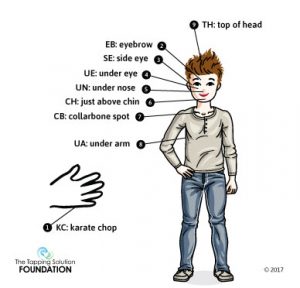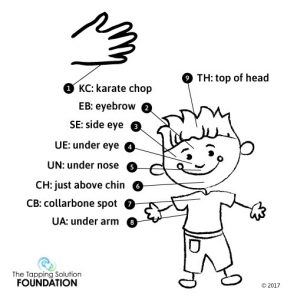
Published By: The Tapping Solution
Written By: Nick Ortner
This post contains excerpts from The Tapping Solution for Parents, Children and Teenagers.
Mark’s Story: From Overwhelm to Empowerment
Mark, 11 years old, had been struggling with social anxiety for years. Diagnosed with Kabuki Syndrome (a rare multisystem disorder) he often felt overwhelmed by large groups, including family and people he already knew. Historically, he’d also had a difficult time adjusting to new social situations. For years his default coping mechanism had been to shut down. Once that happened, it typically took a long time for him to return to normal functioning.
Hoping to ease his intense anxiety, his mother, Rose, had introduced him to Tapping in the last years of elementary school. Thankfully, Mark had responded positively. Each time they used it, he was able to release his anxiety and relax into whatever he was doing.
One evening, Rose took Mark and her older son to a friend’s house for dinner. Her friend had two children of her own, and Rose was hoping that Mark would be willing to play with them. When they arrived, he did join the group.
Before long, however, the two older boys began making a point of excluding Mark from their game. Mark’s usual response to that type of situation was to yell, scream and cry. Often he would get so worked up that he’d begin hitting himself. Once that happened, it would take hours before he could be calm again.
This time, however, Mark quietly came upstairs to find Rose, tapped her on the arm and whispered in her ear that he was feeling frustrated and wanted to go do some Tapping in the bathroom. Thrilled at his request, Rose jumped up and followed him. Once in the bathroom where no one could see, they started Tapping using statements like, “Even though they’re leaving me out of the game, I’m a really cool kid and I’m okay!”
After a few rounds, Mark was noticeably calmer. His body relaxed, his fists weren’t clenched anymore and he was smiling. He looked at Rose and told her he felt ready to go back and play with the other kids. He gave her a big hug and a high five coupled with an excited, “Thanks, Mom!” Everyone had a great time for the rest of the evening.
Learning How to Take Control
For years, Rose had been unsure whether Mark would ever be able to regulate his own emotions. Seeing him take charge of the situation and seek Rose out to do Tapping when he needed it was more progress than she’d dared to hope for.
As exciting as that evening was, though, it’s not the end of the story. In addition to social gatherings, Tapping also became an important part of Mark’s school experience. Thanks to Tapping, in fact, Mark successfully started attending a middle school with over 1,600 kids. This was huge progress compared to 4th and 5th grades, when he’d often come home from school crying, overwhelmed by frustration about homework, how much he hated school and how “stupid” he felt he was.
On the days when Mark was willing, he and Rose would do some Tapping, with Rose doing the Tapping on the points for him. As often as possible, Rose made a point of using Mark’s words, which were often phrases like, “Even though I can’t do this stupid homework, I’m a really cool kid and I’m okay!” Moving through the other Tapping points, they might then say, “This stupid homework… I can’t do this stupid homework… homework is stupid… I’m stupid… I hate homework.”
Nearly every time, Mark’s entire body would relax after a few rounds. They would then take a deep breath together and she’d ask him how he felt. After another round or two, they’d finish with one final round of positive Tapping, using phrasing like: “I’m a smart kid… I can do this… homework isn’t so bad… I’ll finish my homework easily.”
Easily able to focus, Mark would then complete his homework. Rose was always amazed by, and incredibly grateful for, their brief moments of Tapping together.
Now that he was in a massive middle school, Mark had also made great progress with the support of his special education team. When we last emailed, in fact, Mark had asked Rose to teach Tapping to his new teacher. Determined to support him in every possible way, Rose was in the process of setting up a meeting to discuss it.
This is one of my favorite stories, not just because of the results Mark has with Tapping, but also because of how much Tapping empowers him to take control of his anxiety and his experience with other kids. Over time, as he continues to use Tapping, he will continue to realize the power he has over his own experience.
That’s a lesson every child, with or without Kabuki Syndrome, can use to thrive in every area of life.
Child Tapping: Overcoming Social Anxiety
If your child is struggling with anxiety, Tapping will promote self-regulating behaviors that can lead to successful social interactions and academic learning. Let’s look at how to use Tapping with your child on their anxiety disorder.
Note: As always, when Tapping with your child, tailor your words to your child’s age and experience.

You can find these tapping diagrams, along with many other free resources, by visiting our collection of parent and teacher items here.
It’s best to tap on specific situations or scenarios, so choose a social situation or scenario that your child can imagine or remember.
Next, ask your child to rate how anxious—or icky, nervous etc.—they feel when they think of it, either on a scale of 0 to 10 or by extending their arms wide apart, showing their anxiety on a “this much” scale (use this if your child is not yet able to understand the concept of a 0 to 10 scale). They can hold their arms far apart to show a larger number, or “very” nervous, or hands closer together to show “less” nervous.
Then begin Tapping:
Karate Chop (Repeat 3 times): Even though I feel nervous when I think about <situation here>, I’m great!
Eyebrow: So nervous/anxious
Side of Eye: I don’t like feeling this way
Under Eye: Makes my stomach feel queasy
Under Nose: I don’t like it
Under Mouth: What if they make fun of me?
Collarbone: Why can’t we play together?
Under Arm: So nervous
Top of Head: That’s okay
Eyebrow: I’m great!
Side of Eye: And everything’s okay
Under Eye: I’m my own person!
Under Nose: I don’t need to worry
Under Mouth: I’m awesome!
Collarbone: People like me
Under Arm: I can be who I want to be
Top of Head: Because I’m great!
Eyebrow: I can have fun
Side of Eye: I can feel good
Under Eye: I can do what I want
Under Nose: And everything’s okay
Under Mouth: I can feel happy inside now
Collarbone: I can feel calm inside now
Under Arm: I can make new friends and get along
Top of Head: Everything’s okay
Again have them rate their anxiety on a scale of 0 to 10, or using the “this much” method of measurement. Keep Tapping until they get the desired relief.
Can I use Tapping for…?
In The Tapping Solution for Parents, Children and Teenagers you can learn how Tapping can be used for many of your child’s needs, such as attentiveness, impulsivity, social concerns, and MANY more!
Whether your child, or student, is dealing with common social issues, school-related anxiety, or a specific diagnosis, this book will support you in understanding your role and providing specific tools to encourage success and lifelong achievement.
The best part is that with every purchase of this book, 100% of the proceeds, in perpetuity, will be donated to The Tapping Solution Foundation to continue bringing free EFT Tapping resources to schools and families, and providing trauma relief around the world.
Until next time…
Keep Tapping!
Nick Ortner
Facebook Comments
Blog Comments
Recent Blog Posts

Middle School Anxiety: From Overwhelm to Empowerment
Written by: Nick Ortner

Tapping into Your Child’s Depression: Shedding “The Blues”
Written by: Nick Ortner



